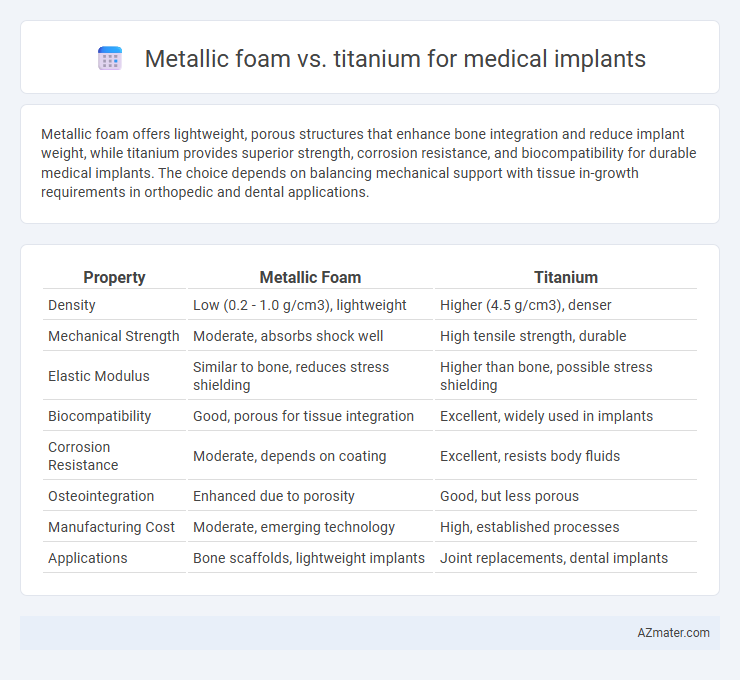Metallic foam offers lightweight, porous structures that enhance bone integration and reduce implant weight, while titanium provides superior strength, corrosion resistance, and biocompatibility for durable medical implants. The choice depends on balancing mechanical support with tissue in-growth requirements in orthopedic and dental applications.
Table of Comparison
| Property | Metallic Foam | Titanium |
|---|---|---|
| Density | Low (0.2 - 1.0 g/cm3), lightweight | Higher (4.5 g/cm3), denser |
| Mechanical Strength | Moderate, absorbs shock well | High tensile strength, durable |
| Elastic Modulus | Similar to bone, reduces stress shielding | Higher than bone, possible stress shielding |
| Biocompatibility | Good, porous for tissue integration | Excellent, widely used in implants |
| Corrosion Resistance | Moderate, depends on coating | Excellent, resists body fluids |
| Osteointegration | Enhanced due to porosity | Good, but less porous |
| Manufacturing Cost | Moderate, emerging technology | High, established processes |
| Applications | Bone scaffolds, lightweight implants | Joint replacements, dental implants |
Introduction to Metallic Foam and Titanium in Medical Implants
Metallic foam and titanium are prominent materials used in medical implants due to their biocompatibility and mechanical properties. Metallic foam offers a porous structure that mimics bone tissue, enhancing osseointegration and reducing implant weight. Titanium, known for its high strength, corrosion resistance, and excellent biocompatibility, remains a gold standard in load-bearing medical implants.
Material Properties: Metallic Foam vs Titanium
Metallic foam offers superior porosity and lower density compared to solid titanium, promoting enhanced osseointegration and bone in-growth in medical implants. Titanium provides exceptional strength, corrosion resistance, and biocompatibility, making it ideal for load-bearing applications. The choice between metallic foam and titanium depends on balancing the need for mechanical stability with the benefits of bioactive structure facilitating tissue integration.
Biocompatibility Comparison
Metallic foam, often made from titanium or its alloys, offers enhanced biocompatibility due to its porous structure that promotes bone ingrowth and vascularization, reducing implant rejection risk. Solid titanium implants exhibit excellent biocompatibility with high corrosion resistance and mechanical strength but lack the porous architecture that facilitates tissue integration. Studies indicate metallic foam's porous surface improves osseointegration compared to solid titanium, making it a promising material for load-bearing medical implants requiring enhanced biological fixation.
Osseointegration Capabilities
Metallic foam exhibits superior osseointegration capabilities compared to solid titanium due to its porous structure, which mimics natural bone architecture and facilitates bone ingrowth. Titanium, while biocompatible and widely used, often requires surface modifications to enhance cellular attachment and integration. The interconnected porosity of metallic foam supports vascularization and nutrient transport, critical factors for long-term implant stability and bone regeneration.
Mechanical Strength and Fatigue Resistance
Metallic foam exhibits lower mechanical strength compared to titanium, limiting its load-bearing capacity in medical implants. Titanium provides superior fatigue resistance, essential for long-term implant durability under cyclic physiological loads. The porous structure of metallic foam promotes osseointegration but requires reinforcement to match the mechanical performance of titanium in critical applications.
Porosity and Bone Ingrowth Potential
Metallic foam exhibits high porosity levels, typically ranging from 60% to 90%, which significantly enhances bone ingrowth potential by facilitating vascularization and nutrient transport. Titanium, particularly in its porous foam forms, offers a balance between mechanical strength and optimized pore architecture, with pore sizes commonly between 100 to 500 microns supporting osteointegration. Studies demonstrate that increased porosity in metallic foams correlates with improved osseointegration and reduced stress shielding compared to traditional dense titanium implants.
Weight and Patient Comfort
Metallic foam implants significantly reduce weight compared to solid titanium, enhancing patient comfort by minimizing implant mass without compromising structural integrity. The porous structure of metallic foam also promotes better bone integration and reduces stress shielding, leading to improved healing and reduced discomfort. Titanium implants, while strong and biocompatible, are denser and heavier, which can occasionally cause patient fatigue and localized discomfort over time.
Corrosion Resistance and Longevity
Metallic foam and titanium both excel in corrosion resistance for medical implants, but titanium's superior oxide layer provides unparalleled protection against bodily fluid-induced degradation, enhancing implant longevity. The porous structure of metallic foam offers benefits like bone ingrowth and reduced stiffness, but its corrosion resistance is generally lower than titanium's, potentially affecting long-term stability. Titanium implants demonstrate extended durability in physiological environments, making them the preferred choice for long-lasting medical applications where corrosion resistance is critical.
Clinical Applications and Case Studies
Metallic foam offers enhanced osseointegration and reduced stress shielding compared to solid titanium, making it advantageous for load-bearing orthopedic implants. Clinical case studies demonstrate improved bone ingrowth and faster recovery in spinal fusion and joint replacement using titanium foam structures. Titanium remains preferred for dental implants due to its biocompatibility and mechanical strength, but metallic foam shows promise in complex reconstructive surgeries requiring lightweight, porous materials.
Cost, Availability, and Future Developments
Metallic foam offers cost advantages and high porosity for enhanced osseointegration but faces limited availability compared to titanium, a well-established implant material known for its strength, biocompatibility, and widespread supply. Titanium implants, despite higher costs, benefit from decades of clinical success and extensive manufacturing infrastructure, ensuring consistent quality and accessibility. Future developments prioritize improving metallic foam's mechanical properties and scalable production methods while titanium research focuses on surface modifications and alloy innovations to enhance implant performance.

Infographic: Metallic foam vs Titanium for Medical implant
 azmater.com
azmater.com